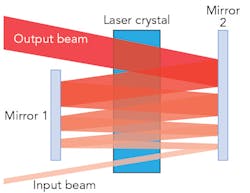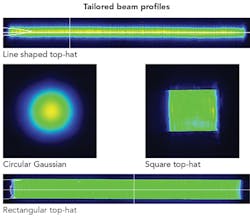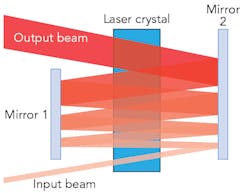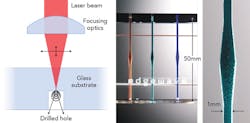Micromachining applications for short- and ultrashort-pulsed lasers
Laser technology allows for flexible beam profiles to serve many micromachining utilities
KEMING DU, DAIJUN LI, and SHIZHOU XIAO
Compact, high-power, high-beam-quality polarized lasers are in demand for applications in industries and research such as micromachining and efficient harmonic generation. Through an optimal combination of crystal shape, cooling, and resonator design, lasers such as the InnoSlab lasers and amplifiers possess short pulse duration, high peak power, high pulse repetition rate, and high beam quality at high average power. They also offer flexibility in beam profile, from circular beam profile through line-shaped one- and two-dimensional top hat beam profiles with rectangular cross-section to serve a variety of unique applications with added value.
Short-pulsed lasers
To get high output power at high beam quality and at low cost, an innovative slab laser concept (InnoSlab) was proposed (FIGURE 1).The diodes are coupled in with their line-shape beam profiles through the resonator mirror. Then, a thin active crystal is partially pumped by the diodes to a thin crystal that is conductively cooled through both large side surfaces, leading to a one-dimensional heat flow perpendicular to the direction of the laser beam. This, in turn, leads to a controllable thermal cylindrical lensing, with no depolarization and no phase distortion.
In this setup, there is a polarizer and a Pockels cell for generating Q-switched pulses. The laser beam traverses the resonator several times and may be decoupled over the edge of the mirror, which may remind some of the old CO2 slab laser.
The entire resonator is shorter than 10cm, which leads to pulse length below 10ns and high peak power. Also, the beam profile can be easily changed from circular Gaussian to line-shaped top-hat or two-dimensional top-hat, which is the basis for optimal industrial application solutions with tailored beam profiles (FIGURE 2).
The parameters of commercially available Q-switched InnoSlab lasers include:
- Pulse energy up to 50mJ;
- Beam quality of M2 <1.3;
- Pulse length down to 4ns;
- Peak power up to 6MW;
- Pulse repetition rate up to 100kHz;
- Average power up to 600W; and
- Availability in 1064, 532, 355, and 266nm wavelengths.
Ultrashort-pulsed lasers
Using the same pumping scheme, slab geometry, and mirror configuration, superior multipass amplifiers can be obtained (FIGURE 3). The secret of the InnoSlab amplifier is large amplification factor; efficient power and energy extraction; scalability of power and energy; and conservation of seeder properties (beam quality, pulse length, etc.). This allows kilowatt power and multi-millijoule energy to be reached for ultrashort pulses and beyond.
Based on the InnoSlab amplifier concept, different models of ultrashort-pulsed lasers have been introduced with:
- Beam quality of M2 <1.3;
- Pulse energy up to 2000μJ;
- Pulse length down to 600fs;
- Peak power up to 200MW;
- Pulse repetition rate up to 100MHz;
- Average power up to 400W; and
- Availability in 1064, 532, 355, and 266nm wavelengths.
Examples of industrial applications
Subsurface engraving. By focusing a short-pulse laser beam into a glass block, the pulse energy is absorbed to a great extent in the focal zone, leading to melting and evaporation of materials. Because of the mechanical stress associated with the melting and evaporation, cracks are induced in the glass that are approximately 100μm in size, and are perceived as marking dots by the naked eye. In this way, subsurface marking of logos and brand names is possible.
Glass drilling. FIGURE 4 shows the principle and possibility of glass processing via forward ablation. In contrast to sub-surface engraving, the focus is placed on the bottom surface while cutting and drilling glasses. In this way, high-precision, reproducible, and high-speed processing of glasses is available. With a Q-switched InnoSlab laser operated at frequency of 100kHz, volume ablation rates >1.5mm3/s can be achieved. This process has been used in drilling holes in glass plate for use in showers, glass lids, and contact holes in photovoltaics.
Cutting and milling of glass. Full-body cutting of glass or sapphire sheet can be realized using the layer-by-layer ablation process with a high-power picosecond laser. A volume rate up to 2mm3/s can be achieved using a 250W picosecond laser (FIGURE 5).
Cutting of transparent and brittle materials. A process similar to subsurface engraving can be used to separate transparent and brittle materials like glass and sapphire. This process, also known as filamentation cutting, is widely used for separation of sapphire and glass sheets. The typical thickness of the sapphire or glass sheet is <0.7mm. The cut edge is of high quality with cracks below 5μm. Cutting speed can be as high as several meters per second.
Engraving of embossing cylinders. 3D microstructuring of large-scale metal surfaces for embossing and printing applications with picosecond lasers has been boosted by the availability of new high-power, ultrashort-pulsed laser sources.
Conclusions
InnoSlab lasers and amplifiers combine diode pumping, crystal shape, cooling, and resonator design, unifying the most favorable laser features: short pulse length, high peak output power, high pulse repetition rate, high beam quality at high average power, and high flexibility in beam profile.
Short- and ultrashort-pulsed lasers with tailored and value-added features, based on this design, are used in a variety of unique applications, such as processing of transparent brittle materials, generation of microstructures, and engraving of embossing cylinders, among other utilities.
KEMING DU([email protected]), DAIJUN LI, and SHIZHOU XIAO are all with EdgeWave GmbH, Würselen, Germany; www.edge-wave.com.





